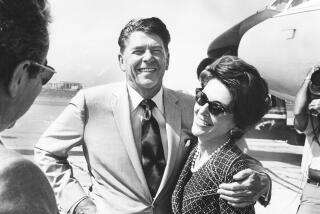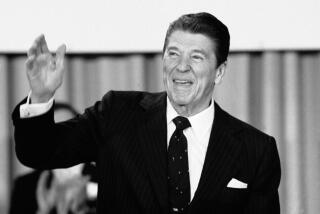Insider’s View
SIMI VALLEY — The research room at the Ronald Reagan Presidential Library and Museum does not inspire awe through design.
It has no floor-to-ceiling stacks, bankers’ lamps, cathedral arches, elaborate moldings or echoing marble floors. Instead, it’s a sunny, casual open space that looks a bit like a public school library--low bookcases, wall-to-wall carpets, nondescript tables and chairs, and a big, colorful presidential seal on one wall.
Library director Mark Hunt knows the research room’s unassuming appearance belies the gravitas of the documents, photographs, videos and artifacts stored one floor below.
Down there is a climate-controlled and carefully secured environment that even scholars rarely get to see; instead, they must wait in the research room for archivists to bring the requested materials up to them.
Today, to celebrate the eighth anniversary of the library center’s opening, Hunt is opening up the full archives to the public. Tours will be offered from 10:30 a.m. to 4 p.m. and are each expected to last about an hour. Hunt said only the first 400 visitors will be guaranteed a tour.
The open house is held annually, with the thought that if the public gets a behind-the-scenes look, more people who visit the center’s museum and gift shop may also be inspired to delve into their own research projects.
“The tour helps them to understand what’s going on behind the scenes, the breadth of the collection,” Hunt said. “Otherwise, all they see are the exhibits. They’re really missing a big part of what we do.”
After a quick tour of the reading room, guides will take guests to the basement archives, which hold 50 million pages of text, 1.6 million photographs and 45,000 audio and videotapes, as well as shelves holding 100,000 trinkets, valuables and other memorabilia given as gifts to the president.
The collection--through the prism of the Reagan presidency--documents America through the 1980s, from the Iran-Contra affair and relations with the Sandinistas, to the war on drugs and national economic policies, to space and defense spending in a standoff that ultimately collapsed the Soviet Union and ended the Cold War.
About 1,000 researchers have used the archives since its opening, including official Reagan biographer Edmund Morris, whose recent memoir “Dutch” was poorly received by many historians. A group of 17 professors from throughout the country will use the archives for a symposium in 2002, for which they will analyze just about every aspect of the Reagan presidency.
“60 Minutes” co-anchor Leslie Stahl and President Dwight D. Eisenhower’s grandson, David Eisenhower, are among those who have used the archives recently, Hunt said. Other well-known researchers include former administration official David Gergen, former national security advisor Robert C. McFarlane, and former domestic and economic policy advisor Martin Anderson.
On a recent afternoon in the research room, Ed Munguia, 27, an undergraduate history student at Cal State Northridge, pored over hundreds of pages of memos and letters in preparation for a presentation on Cold War conflicts in Central America. Munguia said being able to access primary-source documents imbues his research with a weight and authority he couldn’t get relying solely on the secondary-source information authors include in their books.
“It’s just incredible,” he said. “I’ve found letters from ordinary citizens and [Reagan’s] responses to them. I’ve seen letters from [U.S. Sen.] Jesse Helms.”
Files from 630 Reagan administration staffers offer researchers an intimate glimpse at some of the higher-profile names of the time. The archives house 273 cubic feet worth of former Atty. Gen. Edwin Meese’s papers, for example. Iran-Contra researchers will find 125 cubic feet worth of Oliver North’s papers, although many of North’s documents remain classified. Also contained in the archives are hundreds of Reagan’s handwritten letters and notes for speeches, including those for his 1987 Berlin Wall address in which he told Soviet President Mikhail Gorbachev to “tear down this wall.”
A collection of 40 walking sticks reflects the gifts Americans sent during Reagan’s recovery from John Hinckley’s assassination attempt. A clear plastic walking stick filled with jelly beans paid tribute to the president’s favorite snack. An antique walking stick that had been a gift from French general Marquis de Lafayette to George Washington was given to Reagan by a private collector.
At 153,000 square feet, the center is the largest of the 10 presidential libraries under the umbrella of the National Archives. Like the other libraries under the archives, it relies heavily on federal funding. This year, U.S. taxpayers spent $1.37 million to preserve Reagan library documents and make them accessible to the public.
Many documents dealing with national security during Reagan’s two terms in office won’t be declassified before 2006--25 years after Reagan took office, said Sharon Fawcett, deputy archivist for presidential libraries at the National Archives in College Park, Md.
“But there’s still a lot of really good stuff in the Reagan library,” she said.


